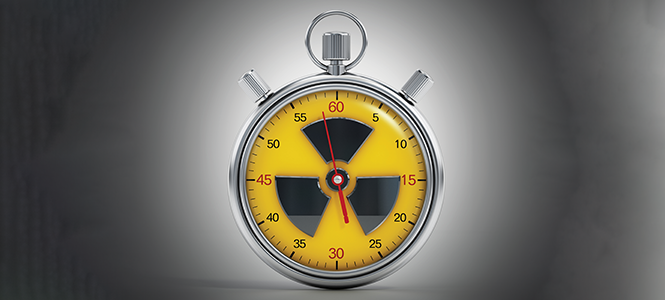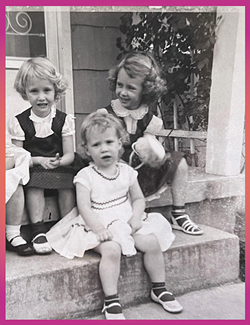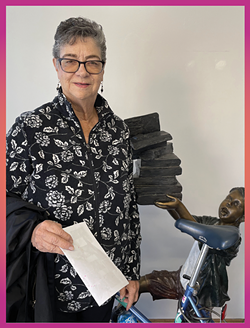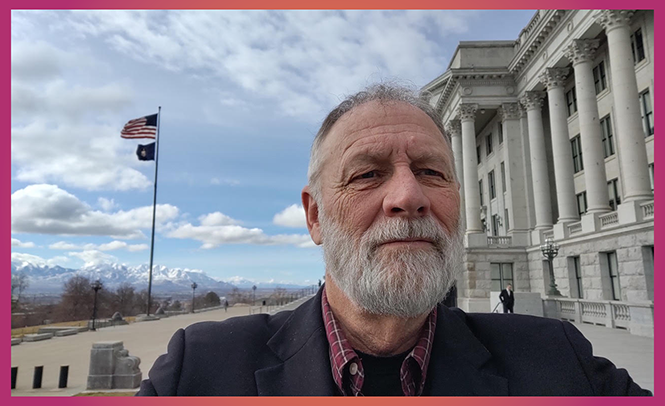Time is running out to give justice and medical aid to Utah's nuclear downwinders
Ticking Clock
By Mary DicksonMy heart sank as I reread the City Weekly cover story I wrote 20 years ago in July of 2004. Under the headline "Northern Exposure: Are Utah downwinders getting screwed?" it examined the 1990 Radiation Exposure Compensation Act, or RECA, and how it excluded residents of northern Utah and neighboring states from federal benefits meant to aid communities that experienced devastating illnesses from nuclear weapons testing in Nevada.
Too many people have continued to suffer in the years since I wrote that story, and too many others have forgotten—or never knew—about the long trail of death left in the wake of four decades of weapons tests and production.
Another two decades later and "downwinders"—or those caught in the path of nuclear fallout—are still fighting for recognition and justice. Recent efforts in Congress to finally expand RECA and include victims of radiation exposure throughout Utah, its surrounding states and Guam failed at the end of December, dashing the hopes of impacted communities across the West.
Worse, without congressional action, the RECA program is scheduled to end this June, leaving many without a critical medical lifeline that includes cancer screenings. For downwinders and uranium miners, it's yet another betrayal by a government that made so many of its own sick.
I'm a journalist, and I'm also a downwinder. But I am not from St. George or southern Utah, as many people mistakenly assume when I tell them that. I grew up in Salt Lake City's Canyon Rim area. It was a seemingly idyllic childhood. We splashed in puddles of rainwater with our friends, mixed snow with vanilla and sugar pretending it was ice cream and drank milk from the local dairy, delivered to our front doorstep every morning.
When alarms went off in grade school, we would crawl under our desks and practice what to do if Russians "dropped the bomb" on us. But it wasn't the Russians who dropped bombs. It was America's bombs and their toxic fallout that got us.
Little did we know that a silent poison was working its way through our bodies. Nor did we know that one day—maybe in one year, 10 years or decades later—the damage to our cells would lead to cancers and other radiation-related illnesses. In my late 20s, I was diagnosed with thyroid cancer and underwent a thyroidectomy. Ensuing years brought other surgeries and health complications. I recovered, but others I knew weren't as lucky.
My older sister died of lupus—an autoimmune disease that has been linked to radiation exposure—when she was just 46, leaving a husband and three children behind. Before she died in 2001, the two of us counted 54 people in our childhood neighborhood who had developed cancer, tumors or autoimmune diseases. I'm still adding names to the list—including my younger sister who has stomach cancer and another sister who is plagued with autoimmune disorders.
Blast Radius
I know people who grew up in other Utah counties and who keep similar lists.
Gary McDonough, a lifelong resident of Salt Lake City, is convinced that fallout from nuclear testing in Nevada is responsible for the deaths of his three brothers as well as other family members, all of whom died of cancer. Eve Mary Verde, who grew up in Price in the '50s and early '60s, says everyone in her immediate family developed cancer, as did the families of both her parents.
"I was shocked to learn from the owner of the mortuary in Price that the average [rate] of cancer deaths in Carbon and Emery counties was 40 percent," Verde said.
As a young girl during years of above-ground testing, Trent Alvey—who grew up in Sanpete County—spent time with her father who was a forest ranger in the La Salle-Manti mountains. She survived cancer, but her father died of esophageal cancer. "When it stormed, the rain brought the fallout down," she said.
Andrea Pickering of Springville lost her husband to thyroid cancer and battles her own health issues. She keeps a list of classmates from the early days of testing who died of cancer. None were covered by RECA.
It's frustrating that so few Americans—even here in Utah—know the painful legacy of the Cold War arms race triggered by Trinity, the world's first atomic bomb detonated in New Mexico in 1945. The Oscar-nominated film Oppenheimer sparked important discussion nationwide and details the creation and detonation of the first bomb, but leaves out what followed—the casualties of the 928 nuclear bombs that exploded at the Nevada Test site between 1951 and 1992, most of them far more powerful than those that obliterated Hiroshima and Nagasaki.
One hundred bombs were exploded in the open air. The winds carried radioactive fallout from those blasts across the country and beyond, where it collided with rain and snow and fell to the earth, working its way into the ecosystem and into our bodies.
Although the government continually assured the public there was no harm, declassified Atomic Energy Commission documents show they knew from the beginning the dangers of fallout and endangered their own citizens.
For four decades, unsuspecting Utahns and residents of other states were repeatedly exposed to radioactive fallout from atmospheric tests, and then from underground tests that leaked radioactive material—some shooting mushroom clouds of debris high into the atmosphere.
Cumulative exposure increases the risk of cancer. According to Mary Olson, founder of the Gender and Radiation Project, those exposed as young children—and especially girls—are more likely to develop cancer at some point during their lifetimes. She also points out that the human embryo and early pregnancies can be so damaged by radiation exposure that the pregnancy fails.
"If the fetus survives the exposure," Olson said, "birth defects and deformations are likely and the risk of childhood cancer is two to four times higher."
Because of the long half-lives of radioactive isotopes—some take thousands of years to decay—radiation from nuclear activities is still present in the environment. All of which means that people are still being diagnosed as a result. In addition, their cancers return, they suffer health complications and face staggering medical bills that have bankrupted many.
And due to DNA damage, second and third generations can potentially experience health problems as well. "Fallout from Cold War nuclear weapons testing is still circulating in our environment, making people sick," Olson said. "And reproductive damage from it is still being passed down."
In the Wind
The fight for justice has been fraught with political hurdles. In 1984, attorneys presented a meticulously researched case, Allen v. United States, on behalf of 1,200 downwinders who had developed radiation-related illnesses. In a damning 400-page decision, Judge Bruce Jenkins acknowledged government negligence and ruled in favor of the plaintiffs. But a higher court reversed his ruling, saying the government can't be sued for doing what it deems necessary.
Downwinders were left to pursue legislative relief, which came in 1990 with the passage of RECA, spearheaded by Utah's Republican Sen. Orrin Hatch and Democratic Rep. Wayne Owens. The act provided $50,000 to those who could prove they developed leukemia or one of 17 cancers and who lived for two consecutive years between 1951 and 1958 or during the summer of 1962 in 10 southern Utah counties or 12 counties in southwestern Nevada and northern Arizona.
While RECA offered life-saving support to those who qualified, anyone living outside the designated boundaries was excluded, as though fallout stopped at county lines.
"The question of where to draw the lines of exposure has always been at the core of RECA," says Lilly Adams, senior outreach coordinator for the nonprofit advocacy organization, the Union of Concerned Scientists. "There's been an underlying feeling that the drawing of these lines has historically been pretty arbitrary. In the years since RECA was first enacted, new studies and information have made it imperative to take a critical look at current boundaries."
Jon Callahan, Ph.D., a Utah laboratory chemist and cancer researcher, said it's clear the federal benefits fall short of covering the scope of impacted communities.
"For decades, the science has shown that the current RECA program is woefully inadequate in compensating all those damaged by the government's nuclear testing program," he said.
A landmark 1997 study from the National Cancer Institute concluded that every county in the continental U.S. received some level of fallout from testing in Nevada, exposing 160 million Americans to radiation. Not all those exposed would get sick, but too many would develop cancer and other radiation-related illnesses without knowing the cause. The study predicted that exposure would cause 11,000 to 212,000 cases of thyroid cancer alone.
Last summer, Princeton researchers mapped fallout patterns from Trinity and 93 of the atmospheric tests in Nevada, offering further evidence of how far fallout spread across the nation. This came as members of Congress were starting their latest push to protect and expand RECA.
"The map shows the extent to which Utah and the West were clobbered by radiation from hundreds of open-air tests," Gary McDonough says. "Evidence from Princeton should alter the political landscape on this issue."
For years, Sen. Mike Crapo, R-Idaho, and Sen. Ben Ray Lujan, D-New Mexico, have tried to update RECA to reflect the scientific evidence that more communities were exposed than originally included in the act. Both their states received extremely high levels of fallout.
In 2021, alongside Rep. Teresa Leger Fernandez, D-New Mexico, and Utah's Republican Rep. Burgess Owens, the senators introduced a bill that would extend RECA for another 19 years and include all of Utah, Nevada and Arizona, as well as Idaho, New Mexico, Montana, Colorado, the territory of Guam and, for the first time, the downwinders of Trinity as well as new categories of uranium miners, many of whom are indigenous. All would receive a uniform $150,000. Critically, the bill included health benefits.
"The $50,000 downwinders receive has never been adequate," noted Callahan. "New treatments for cancer are now many times more expensive and often far more complicated. For example, newly approved cell treatments for leukemia are estimated to cost between $500,000 and $1 million."
Sticker Shock
The 2021 bills gained impressive bipartisan support, but never made it to the floor for a vote. They were reintroduced last July, this time without Utah's Rep. Owens as a co-sponsor. Republican support in the House fell to Rep. James Moylan, R-Guam.
Though so many Utahns would benefit from the bills' provisions, Utah's congressional delegation is distressingly absent this time around. While Owens worked behind the scenes to gain the support of fellow Republicans—including Utah Reps. Blake Moore and Chris Stewart—none of Utah's delegation co-sponsored the most recent efforts. Republican Rep. Celeste Maloy—who succeeded Stewart in November—told the Utah News Dispatch last month that expanding RECA is high on her list of priorities. She has not yet signed on as a co-sponsor. "What we need is a good, clean RECA bill that helps people in Utah that isn't so broad it can't get funded," Maloy told the Dispatch.
Steve Erickson of Downwinders Inc.—who says including Western states in RECA and increasing the amount of compensation is long overdue—stresses that the RECA expansion has been supported by the Utah Legislature and the Western Governors Association. "All of which signals the will of Utah citizens," he said.
None of Utah's delegation has said publicly why they aren't supporting the RECA bills, but cost is likely a factor. The Congressional Budget Office projected a price tag of $143 billion over 10 years, which advocates insist is unrealistically high. Over the past 33 years, RECA has paid out only $2.5 billion. By comparison, the U.S. has spent over $12 trillion on nuclear weapons since the Manhattan project and plans to spend another $1.5 trillion over the next 30 years. Meanwhile, Congress approved $26 billion in additional funding for weapons that the Pentagon never asked for.
Historian Sarah Fox, author of Downwind: A People's History of the Nuclear West, sees RECA as a public health and social justice issue. She said she is disappointed with the lack of support from Utah politicians. "I think people in Utah want to forget about it," Fox said. "But the issue of radiation exposure requires leadership and historical memory on the part of journalists, politicians and researchers."
Fox emphasized that nuclear radiation is not just a problem from a long time ago, but one that remains today.
"It created an ongoing public health crisis in communities across Utah and the broader West that requires continued research, health screening programs and funding for compensation," she said. "It's incumbent on ethical politicians—especially in heavily impacted states like Utah—to protect programs like RECA."
Counting Down
Unfortunately, it's been left to politicians from other states to do what Utah's elected officials have not. In a surprise move last July, Sen. Josh Hawley, R-Missouri, introduced the Crapo/Lujan bill as an amendment to the National Defense Authorization Act. He added language to include the St. Louis area after learning that radioactive waste from the Manhattan Project was buried next to schools and perilously close to a nearby creek.
Swayed by a group of St. Louis mothers convinced that the waste was responsible for the high rates of cancer they and their families have suffered, Hawley has become an impassioned champion of those harmed by radiation exposure in his state and elsewhere. At the end of July, the Hawley amendment passed the Senate 61-37 with strong bipartisan support, providing victims a long-awaited glimmer of hope. Notably, however, Utah Sens. Mike Lee and Mitt Romney voted against including the amendment in the national defense budget, something Mark Shapiro—filmmaker of Downwind—calls "unforgivable."
"The votes added insult to injury from the very elected officials who are supposed to support them," he said.
Downwinders' efforts have garnered the attention of President Joe Biden, who said during an address in New Mexico that he was prepared to "help make sure those people are taken care of." At a Salt Lake City event the following day, the president publicly expressed his support for "those who have been impacted."
With support at the highest level and with the film Oppenheimer providing a golden opportunity for downwinders to build public and congressional awareness, things seemed to be in perfect alignment.
Then, just before Congress recessed in December, Sen. Minority Leader Mitch McConnell, R-Kentucky, and House Speaker Mike Johnson, R-Louisiana, stripped the amendment from the defense budget bill—a devastating blow for victims.
Dawn Chapman, a member of the group Just Moms STL in Missouri, said she went into her bathroom to cry upon hearing the news. Another group of impacted community members from across the West tearfully commiserated during their weekly Zoom meeting the next day.
"I won't give up until we win, or I'm in the ground," said Tina Cordova of the Tularosa Basin Downwinders, who spearheads that group and encouraged members to focus on the progress and alliances they had made. "It's the farthest we've ever come," she reminded them.
"Everything in Congress is so up in the air," says Adams, of the Union of Concerned Scientists. "We're focusing on the next month-and-a-half to see if it can be attached to any other bills headed for approval. We can't just kick this can down the road again. The U.S. government has been doing that literally for 80 years. Those people affected just do not have time."
As determined sponsors look at all options, including reintroducing stand-alone bills, the clock is ticking. RECA expansion and the program's very existence remain in limbo as it is set to expire in June. Sponsors, activists and advocates are urging the public to pressure their representatives. Calls and letters, they say, do make a difference.
"Too many continue to suffer, and too many have died waiting for the help they need," Steve Erickson says.
Nothing will bring back what survivors have lost—their health and their loved ones—nor will it ease the burden of staggering medical bills and the emotional toll they and their families have suffered. But strengthening RECA would at last help Utahns and others who have paid the price of America's nuclear weapons program achieve the recognition and justice they deserve.
Latest in Cover Story
Readers also liked…
-
Forget the family pedigree—Robert F. Kennedy Jr should not be the next president of the United States
Trojan Horse
- Jun 21, 2023
-
Women decry harassment and toxic culture at St. George auto dealership
Men at Work
- Oct 11, 2023








